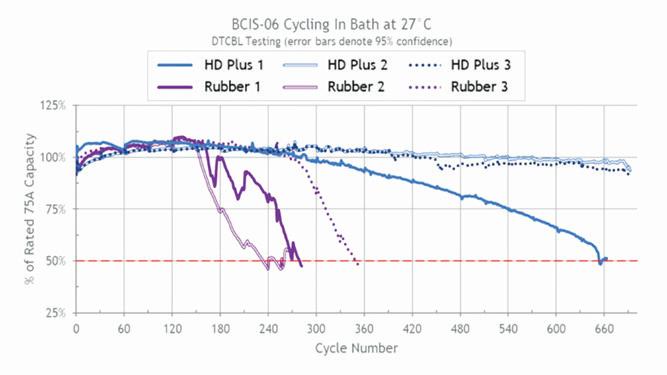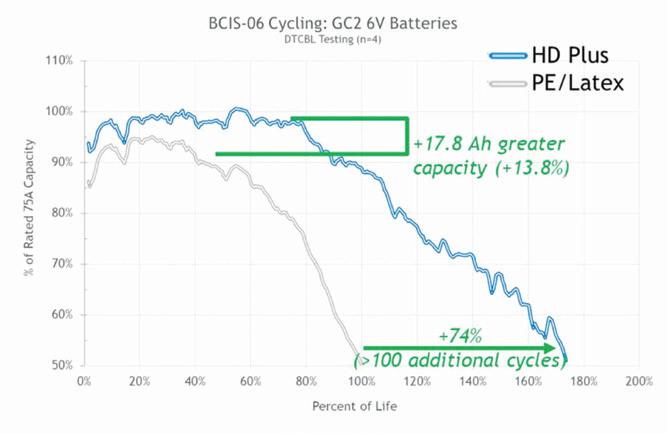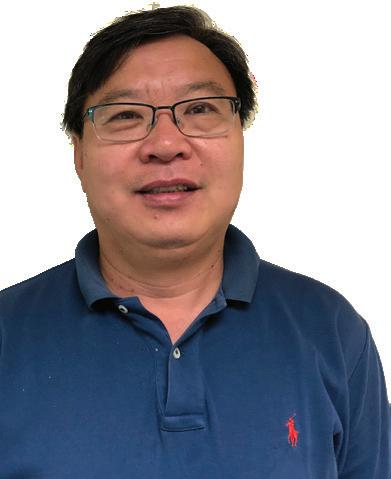
8 minute read
Daramic: Taking the HD plus separator to new heights
from BCI Yearbook 2022
by hamptonhalls
Daramic has featured in the innovation awards since their inception in 2016 and has always been a strong contender to gain top ranking. This year it presents HD plus, another step change in separator performance.
The battle for the yet better separators
Advertisement
Daramic has a long history as a pioneer in the advancement of battery separators. So in one respect it’s perhaps fitting that the inventor of the polyethylene battery separator should unveil the next way forward in battery separator design and capabilities. The product known HD Plus is a step change in the development of deep cycle batteries and is an advancement of an early product, simply called Daramic HD.
One of the technological problems associated with the lead-acid battery is the self-discharge of the negative plate as a result of the deposition of antimony on to the sponge lead electrode, a process known as antimony poisoning. This results in gassing and water loss and eventually a shorter battery life. Antimony, however, is a useful additive for lead batteries in that it can increase conductivity of the grid enabling deeper and better cycling.
Daramic points to five features that the new HD Plus separator provides. These are: • Improved polyethylene formulation suppresses the effects of antimony poisoning, yielding longer life • New formulation provides lower internal resistance, improving charge acceptance and increasing capacity • Sealable for both envelope or sleeve automation provides protection from short circuits and higher manufacturing yields • High oxidation resistance • Optional glass mat for active material retention
The key benefits of HD Plus, according to Dawn Heng, vice president and managing director for global marketing and Northeast Asia, is that firstly, it exceeds battery life requirements by counteracting the negative effects of antimony poisoning including superior oxidation resistance and reduced water loss. And secondly, on average, HD Plus increases capacity by 9%13% versus standard separators, resulting in increased back-up time for users.
Daramic has always been a regular and strong contender in the BCI innovation awards.
In 2019, Daramic and Huff Technologies developed a way of
Daramic HD Plus at least doubles cycle life

HD Plus gives more than 100 additional cycles compared to PE rubber/latex separators HD Plus also gives >17 Ah additional capacity
HD Plus gives longer life and more capacity than PE Hybrid separators
better simulating how batteries perform in the real world by simulating how they move around during everyday use. For this it received a distinguished mention.
The product was the Daramic Shuttle Table which was designed to mimic real world scenarios during testing. It was developed because the companies acknowledged that in all types of environments, vehicles and the lead acid batteries they use are constantly moving. The system allows for a direct comparison between batteries based on different working patterns and battery environments. It will enable the testing and validation of a variety of passive acid mixing devices, the company said, as well as many standard industry tests performed while the batteries are in motion. This includes the testing of tall motive power and deep cycle batteries, while providing a safer battery testing environment.
In 2018 the firm showcased its latest product using Carbon Coated Separator Technology. Developed to support operations in partial state of charge, utilizing the separator as a carbon carrier, dynamic charge acceptance is improved. It does this by reducing sulfation crystal growth, delivering a more active surface area on the plates for improved conductance of the electrode.
In 2017, using advanced computational fluid dynamics, Daramic developed two new separator solutions — Daramic EFS and Daramic RipTide. Daramic EFS is specifically designed to support startstop vehicle batteries by reducing the battery’s internal resistance and improving voltage drop and CCA. Daramic RipTide combines the latest innovations of Daramic with novel separator profile designs using advanced computational fluid dynamics computer modelling to enhance EFB durability by reducing acid stratification in a partial state of charge environment, which is more typical in start-stop applications.
Daramic’s first entry to the BCI Innovation Awards in 2016 was for a product innovation invented three years ago with research continuing on further refinements. Called DuraLife, this helps protect and maintain the quality and performance in battery designs that use less lead content — a technique that many battery producers have adopted as a way of reducing the overall cost of their products.
Attribute
Backweb thickness (mm) Electrical resistance (mΩ-cm2) Porosity (%) CMD elongation (%)
*Daramic Internal Testing
Typical value*
Rubber HD Plus™
0.400 0.300
450 165
38 55
78 200
The key benefits of HD Plus are that firstly, it exceeds battery life requirements by counteracting the negative effects of antimony poisoning including superior oxidation resistance and reduced water loss. And secondly, on average, HD Plus increases capacity by 9%-13% versus standard separators, resulting in increased back-up time
for users. — Dawn Heng, Daramic
WHY DEEP CYCLE BATTERIES MATTER
In North America, the lead acid battery industry delivers around 20 million deep cycle batteries, annually, they are used in a variety of applications and golf carts, floor scrubbers and general utility vehicles rely on lead acid batteries to deliver higher capacities for extended life on the golf course, the showroom floor and out in the field,
Alternative battery technologies, especially lithium ion are pushing the boundaries regarding what is expected of deep cycle battery performance.
As a result, lead acid batteries are facing unprecedented challenges in deep cycle markets. to close the gap on cycle life capacity and operations and partial state of charge users of lead acid. The Daramic HD Plus separator will be yet another tool challenging the in-roads of lithium into traditional lead markets.
Deep cycle batteries are pushing for longer battery life that far exceeds the warranty periods offered today. Lowering warranty return rates through a more robust battery design allows battery manufacturers to increase cost savings while meeting these shifting market needs.
In addition to longer battery life extended run times are also becoming a priority to meet this need users need higher capacity lead asset batteries to power these deep cycle vehicles.
Lead acid batteries are facing unprecedented challenges in deep cycle markets to close the gap on cycle life capacity and operations and partial state of charge users of lead acid. The Daramic HD Plus separator will be yet another tool challenging the inroads of lithium into traditional lead markets.
Hollingsworth & Vose has nominated PowerFill for the innovation which it says is an improved and faster acid fill that can include a 12% increase in battery capacity and cycle life.
Better acid filling, better battery performance
One challenge many customers encounter during AGM battery assembly is the slow and uneven filling of acid electrolyte. Slow filling reduces the battery assembly speed while uneven acid distribution in the AGM separator and plates potentially cause dry spots and black spots on the plates during battery formation. Furthermore, uneven acid distribution can degrade battery performance.
A key factor affecting the acid filling speed is the gas pocket trapped toward the center of the plates and AGM separator. The gaseous species in the pocket is air and possibly CO2 generated by the reaction of the acid with carbonate species in the plates. The gaseous species have the tendency to hinder the flow of the acid into the center area, unless removed from the battery.
H&V has recently developed PowerFill AGM to solve these challenges by enhancing the surface of the separator to create open channels. With the open channels on the PowerFill AGM separator, the gaseous species in the pocket can escape more easily from the battery during the acid filling process, thereby allowing acid to flow quickly and evenly into the center of the plates/AGM. The PowerFill patented technology can be applied to various types of AGM, and the resultant separators still retain the same strength and compression retention behaviour of the base AGM. PowerFill has demonstrated it can increase production throughput and battery performance for a wide-range of applications.
“H&V is a global leader in filtration and energy storage solutions. Our advanced materials are used in nearly every industry and touch every aspect of modern life. Wherever you work, live or travel, chances are an H&V solution is close by, contributing to a cleaner, healthier, more sustainable world,” says the firm.
“H&V is the lead battery industry’s only vertically integrated Absorbent Glass Mat (AGM) producer.”
POWERFILL — ADDS VALUE TO BATTERY PRODUCERS AND END-USERS IN THREE WAYS.

First, it increases battery assembly speed and throughput. PowerFill has demonstrated electrolyte acid filling time can be reduced over 50% allowing battery producers to reduce cost.
Second, PowerFill improves the quality of lead batteries since acid filling is uniform across the AGM separator and plate/electrode. Better batteries means improved battery assembly yield.
Finally, PowerFill has demonstrated battery performance improvements to include 12% increase in battery capacity and cycle life.
Zhiping Jiang holds a PhD in Chemistry from Rensselaer Polytechnic Institute (1990) and MBA from University of Massachusetts at Lowell (2005). He began his industrial career in 1992 after a two-year’s post-doctoral study at Materials Processing Center/Massachusetts Institute of Technology. Over the years, he has worked on product and technology development in various areas including batteries, battery materials and separators. In 2012 he joined Hollingsworth & Vose Company as the chief scientist in the Battery Division. He has been awarded with 32 US patents, and received R&D Magazine’s Year 2000 R&D 100 Award for technology innovation.
ZHIPING JIANG











